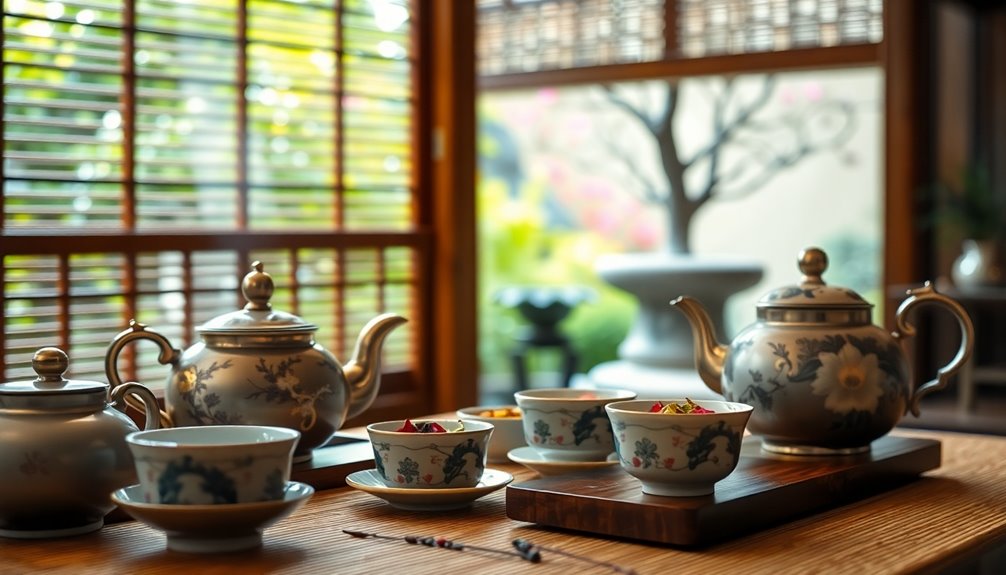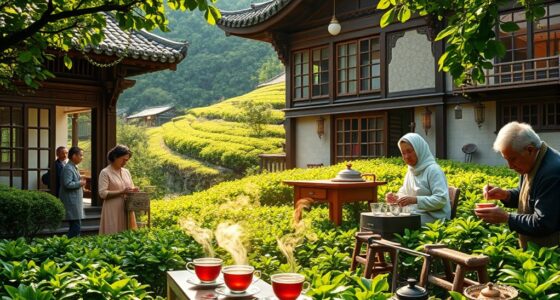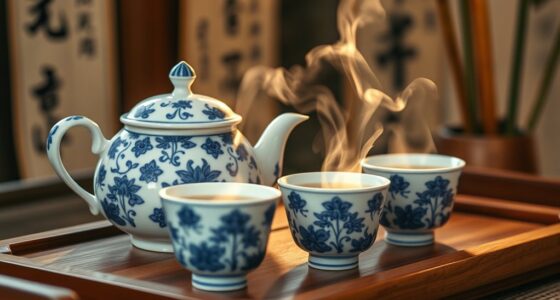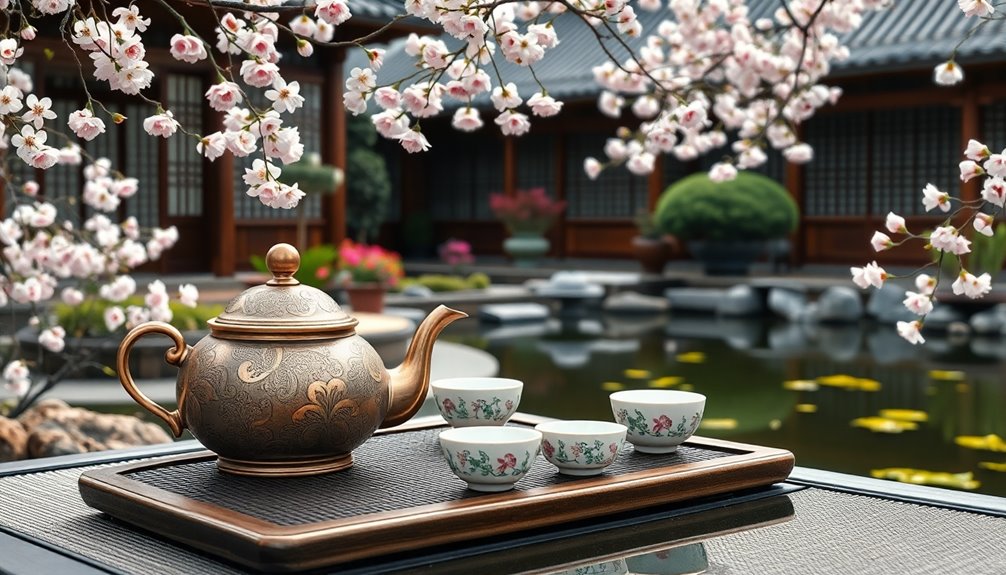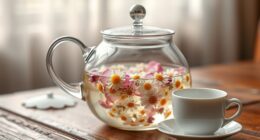Tea culture is much more than just drinking tea; it's about connection and celebration. When you participate in a tea ceremony, like in Japan or China, you embrace mindfulness and respect. This helps you bond with others and appreciate the flavors in your cup. Globally, tea symbolizes hospitality, inviting friends or family to share stories and laughter. Plus, with diverse flavors from herbal teas to spiced chai, there's something for everyone. As you explore this rich world, you learn how history and tradition shape tea's significance. You'll discover much more about the fascinating cultural layers behind each sip!
Key Takeaways
- Tea culture embodies historical, social, and spiritual significance, transcending mere consumption to foster meaningful connections among people.
- Ceremonial practices, such as Japan's Chado and China's Gongfu Cha, emphasize mindfulness, respect, and appreciation for the art of tea-making.
- The global tea market reflects economic importance, with a value exceeding $200 billion, showcasing tea's role in trade and cultural exchange.
- Cultural traditions surrounding tea, like British afternoon tea and Indian chai, highlight hospitality and community bonding beyond just drinking tea.
- Understanding and respecting diverse tea rituals promotes awareness of cultural heritage, reducing the risk of cultural appropriation in tea practices.
Introduction

When you delve into tea culture, you'll discover a rich tapestry of rituals and practices that highlight tea's historical, social, and spiritual significance around the world.
In places like China, drinking tea isn't just a habit; it's part of a tea ceremony that emphasizes mindfulness, respect, and beauty. These ceremonies transform tea into a meditative art form, making each cup special.
In British culture, tea plays a similar role, often serving as a symbol of hospitality. When friends and family gather for tea, they connect and share stories, creating warm memories.
The cultural significance of tea is profound; it's not just about sipping a beverage, but about the relationships and traditions that grow around it.
Tea also has deep roots in history as a medicinal brew. Ancient Chinese cultures valued its healing properties, paving the way for tea's journey to become a global favorite.
Today, the tea market is booming, valued at over $200 billion, showcasing its impact on economies and cultures alike.
Historical Trade Route Influence
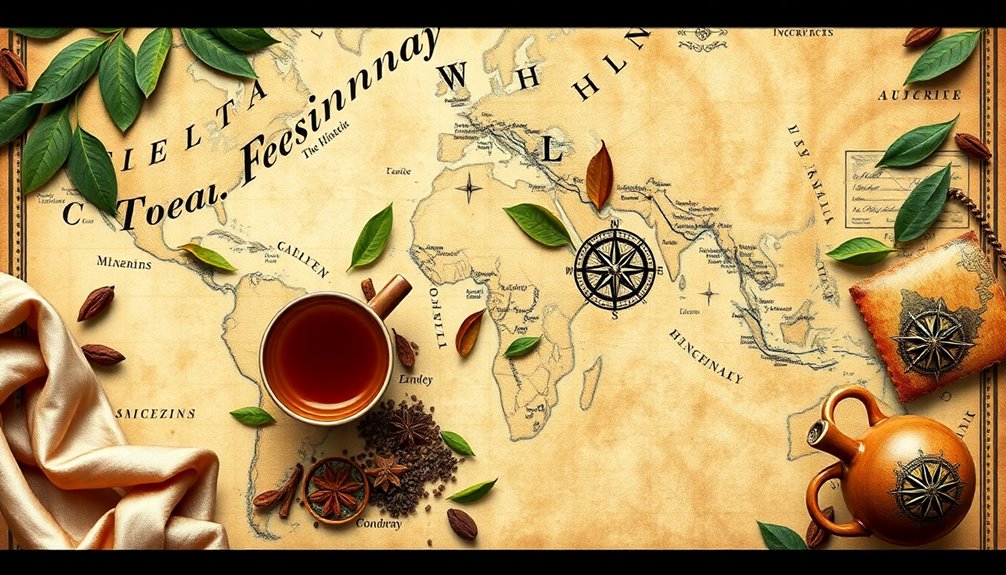
The influence of historical trade routes on tea culture is profound, shaping how this beloved beverage spread across continents. In China, during the Tang Dynasty, tea gained immense popularity, leading to the establishment of trade routes. The Silk Road became a vital pathway, allowing Chinese tea to reach Central Asia and beyond. This trade fostered cultural exchanges, introducing diverse tea drinking customs.
By the 17th century, Dutch and British traders recognized tea's value and set up East India Companies. These companies played crucial roles in popularizing tea in Europe, influencing social customs around tea drinking. Imagine sipping tea during a lovely afternoon gathering, a tradition that took root from these early exchanges!
The Opium Wars in the 19th century highlighted tea's economic significance, as Britain sought to secure imports from China. As tea became a valuable commodity, it shaped local economies and agricultural practices in producing countries. Furthermore, the popularity of tea led to the development of various herbal tea blends that are now enjoyed globally.
Today, the legacy of these historical trade routes continues to influence how we enjoy tea, connecting us to the rich tapestry of cultures that have celebrated this drink for centuries. So, next time you sip your favorite blend, think about the incredible journey it took to reach you!
Global Tea Consumption Trends
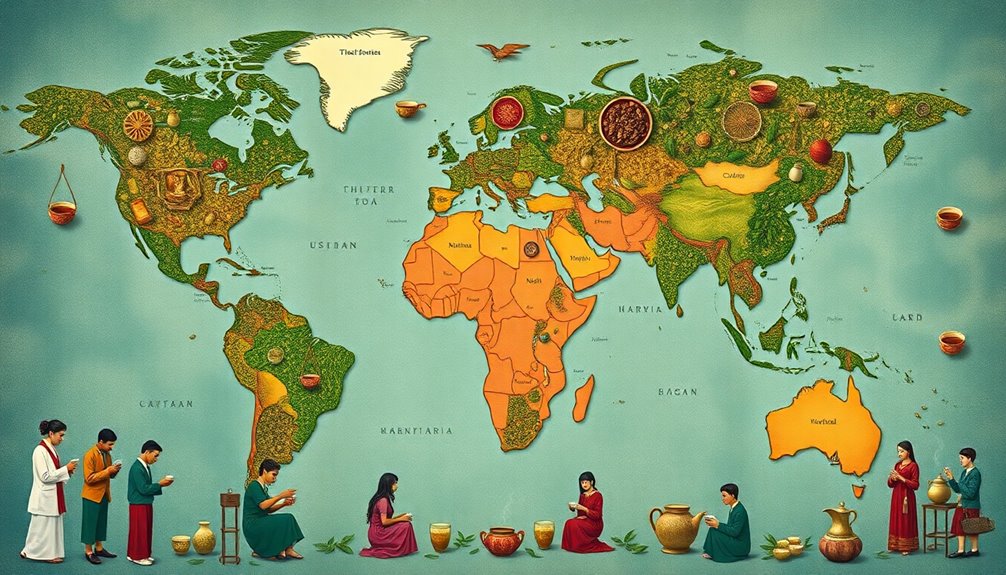
Rising global tea consumption reflects a growing appreciation for this versatile beverage, with trends indicating that over 6 million metric tons were enjoyed in 2022 alone.
You might be surprised to learn that China and India account for about 60% of the world's tea production! This shows how deeply rooted tea is in these cultures.
One exciting trend is the booming specialty tea market, projected to reach $13 billion in the U.S. by 2025. Health-conscious consumers are driving this shift, seeking high-quality and sustainably sourced teas.
Traditional Chinese tea continues to attract attention, but you'll also find unique flavors popping up everywhere.
In Western countries, especially the U.S. and the UK, cold-brew and iced teas are becoming increasingly popular. This change reflects your preferences for refreshing options.
Plus, herbal tea consumption is on the rise globally, as many of you're drawn to the health benefits and diverse flavors these teas provide.
Whether you enjoy a classic British tea or a flavorful herbal blend, there's never been a better time to explore the world of tea.
Ceremonial Practices in Tea Culture

Tea isn't just a beverage; it's a profound cultural experience that varies dramatically around the world. Many cultures embrace ceremonial practices that highlight the beauty and meaning of tea.
In Japan, for instance, the Chado tea ceremony emphasizes mindfulness and respect. Each gesture is deliberate, turning tea preparation into a meditative ritual.
On the other hand, China celebrates Gongfu Cha, which also focuses on the art of tea-making. This practice encourages careful attention to detail, allowing you to appreciate the flavors and aromas fully. Both ceremonies promote a sense of community, inviting friends and family to gather and share in the experience.
In India, serving Chai spiced with cardamom and ginger showcases hospitality. It's a warm welcome to guests, reflecting the cultural heritage of the region.
Meanwhile, the British afternoon tea tradition fosters social interaction, where tea is enjoyed alongside sandwiches and pastries.
These ceremonial practices not only celebrate tea but also strengthen bonds among people. They remind us that tea is a connector, intertwining mindfulness, community, and cultural heritage, making every cup a shared experience rich in meaning.
Cultural Appropriation Debates

Cultural appropriation debates surrounding tea practices highlight the tension between appreciation and misrepresentation. When people adopt traditional tea rituals, like the Japanese tea ceremony or chai, without understanding their cultural significance, it can lead to concerns.
For example, Chado, the Japanese tea ceremony, is rooted in Zen Buddhism and emphasizes respect and mindfulness. If non-Japanese individuals adapt it casually, they might dilute its true meaning.
In South Asia, chai is more than just a drink; it's a communal experience with deep historical roots. The commercialization of chai raises questions about cultural appropriation, as it risks overlooking its importance in social gatherings.
Critics argue that the casual adoption of tea rituals in Western cultures can miss the rich histories and customs from places like China and Japan, where tea holds a vital role in social and spiritual lives.
These conversations remind us to recognize the origins of tea traditions. By honoring these practices, we can foster respect and understanding among diverse communities.
Engaging with tea culture means appreciating its roots and celebrating its unique stories, ensuring that we share in the joy of tea without losing its significance.
Practical Applications

The essence of tea culture extends beyond mere enjoyment; it fosters social connections and enriches daily experiences. When you sit down for a cup of traditional tea, you're not just drinking; you're engaging in social bonding. Gatherings centered around tea create a warm atmosphere, sparking conversations that strengthen relationships across cultures.
Making tea can also be a mindful practice. In Japanese tea ceremonies, the preparation becomes a meditative act, promoting tranquility and respect. Similarly, in India, serving chai to guests reflects hospitality and community spirit, showing how tea plays a vital role in social customs.
The economic implications of tea are significant, too. The tea industry employs millions around the world, impacting local economies.
As a tea drinker, you can support ethical sourcing by choosing high-quality loose-leaf teas over tea bags. This choice not only enhances your experience but also raises awareness about the origins of tea and its production methods.
Frequently Asked Questions
Why Do so Many Cultures Drink Tea?
So many cultures drink tea because it fosters connection and community. You'll find it serves as a comforting ritual, symbolizes hospitality, and adapts wonderfully to local tastes, making it a beloved beverage worldwide.
What Culture Drinks the Most Tea?
You'll find that Turkey drinks the most tea per capita, with each person consuming around 3.16 kg annually. Their tea culture is vibrant, showcasing a strong social connection and daily rituals surrounding this beloved beverage.
Why Is Tea so Influential?
Tea's influential nature stems from its deep historical roots, economic significance, and diverse cultural practices. You experience connections and rituals that foster community, making tea not just a beverage, but a bridge across different societies.
What Culture Is Known for Tea?
When you think about tea culture, countries like China, Japan, India, Thailand, and Great Britain come to mind. Each nation offers unique traditions, flavors, and practices that celebrate tea's significance in their daily lives.
Conclusion
Tea culture goes beyond just sipping a warm cup; it's about connecting with history, people, and traditions. From ancient trade routes to modern-day ceremonies, each cup tells a story. You can explore this rich world by trying different teas, joining a tea ceremony, or learning about global tea practices. So, grab a cup and dive into the fascinating journey of tea! Who knows what new flavors and stories await you? Happy exploring!

